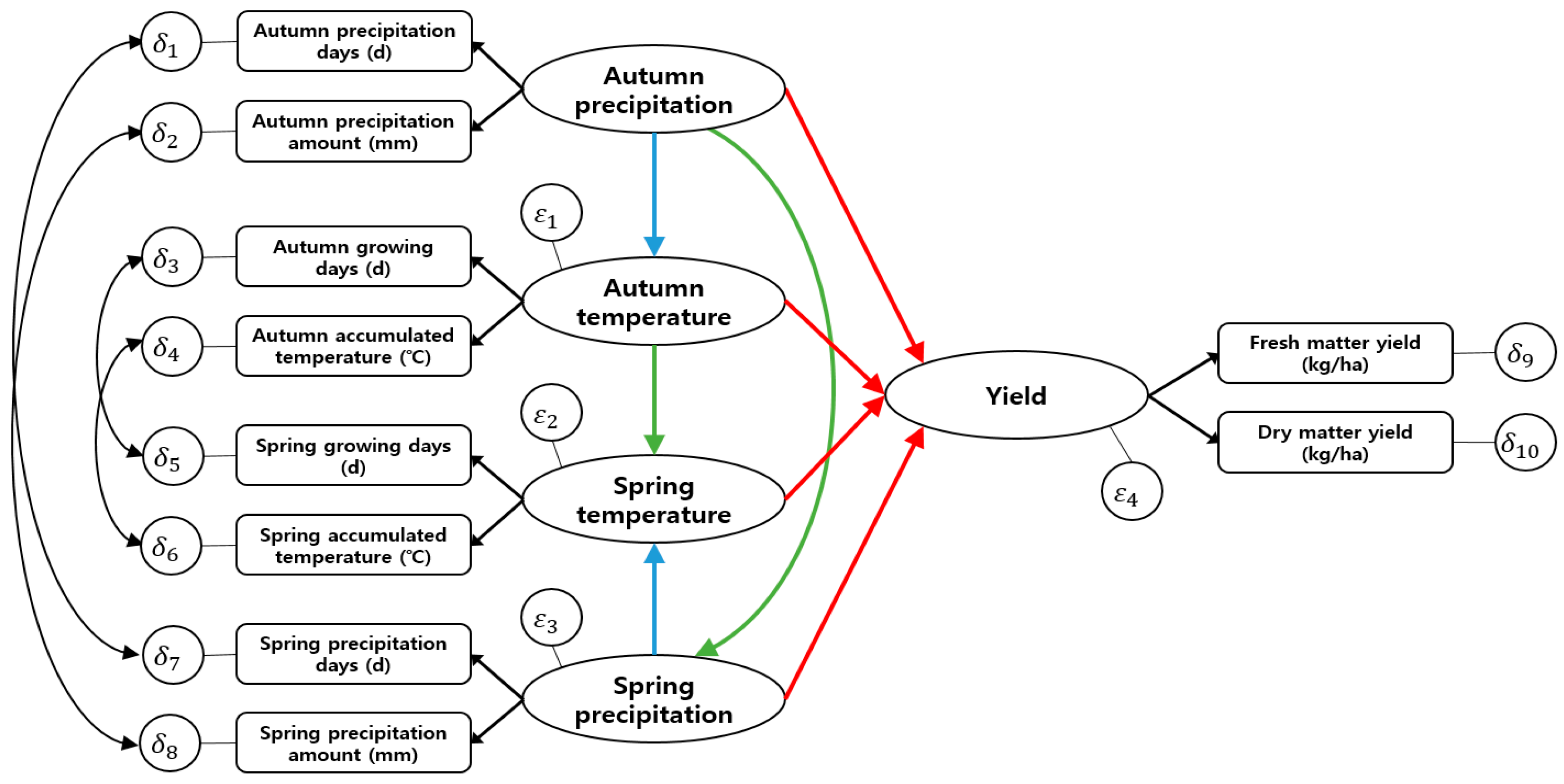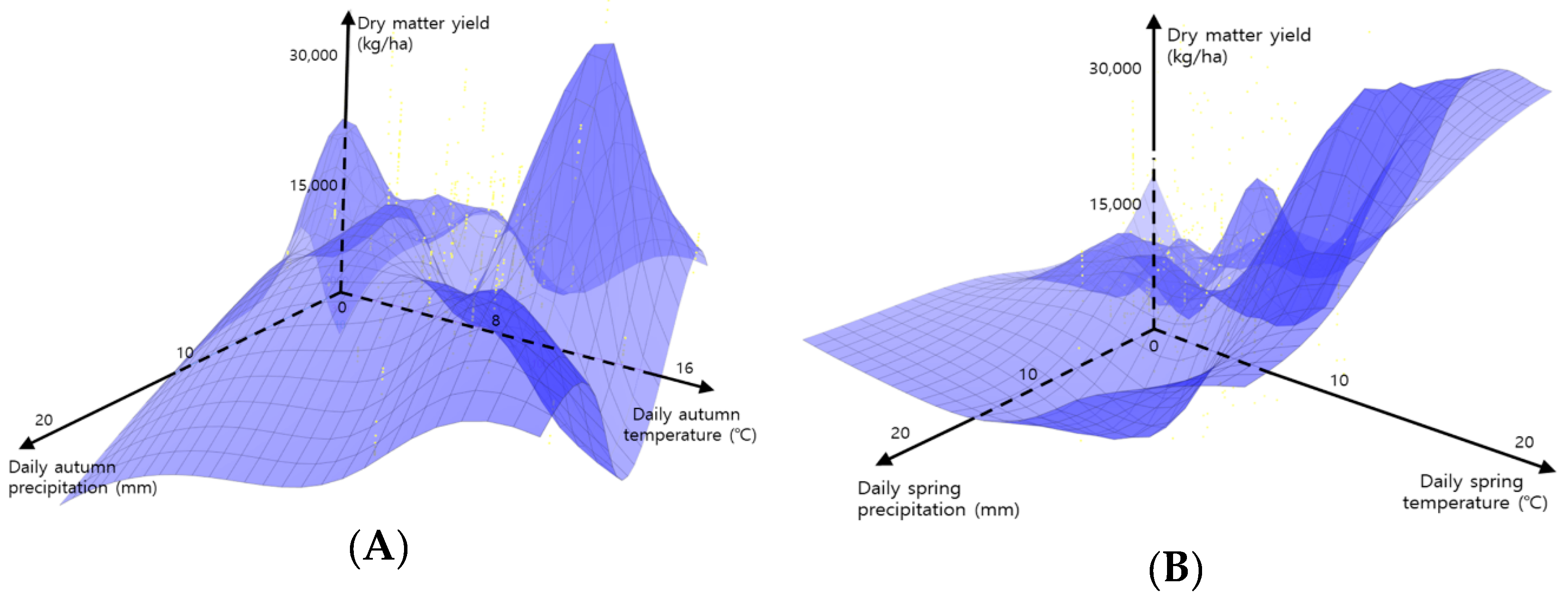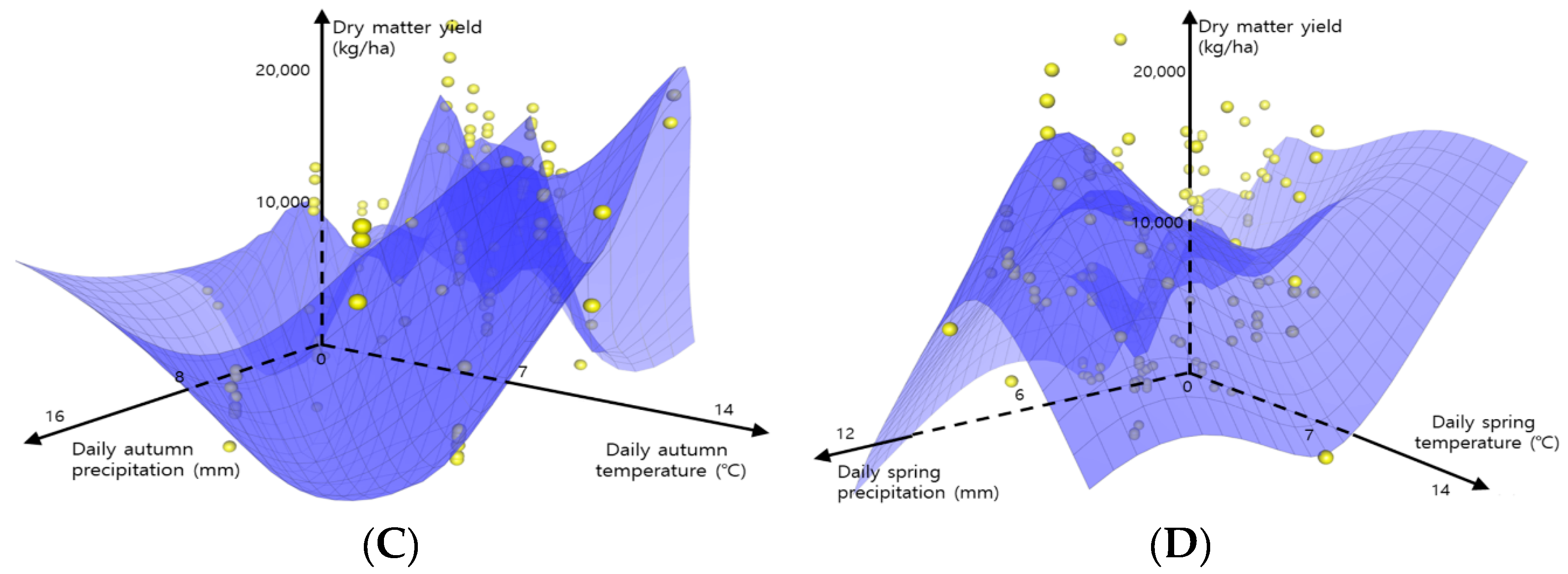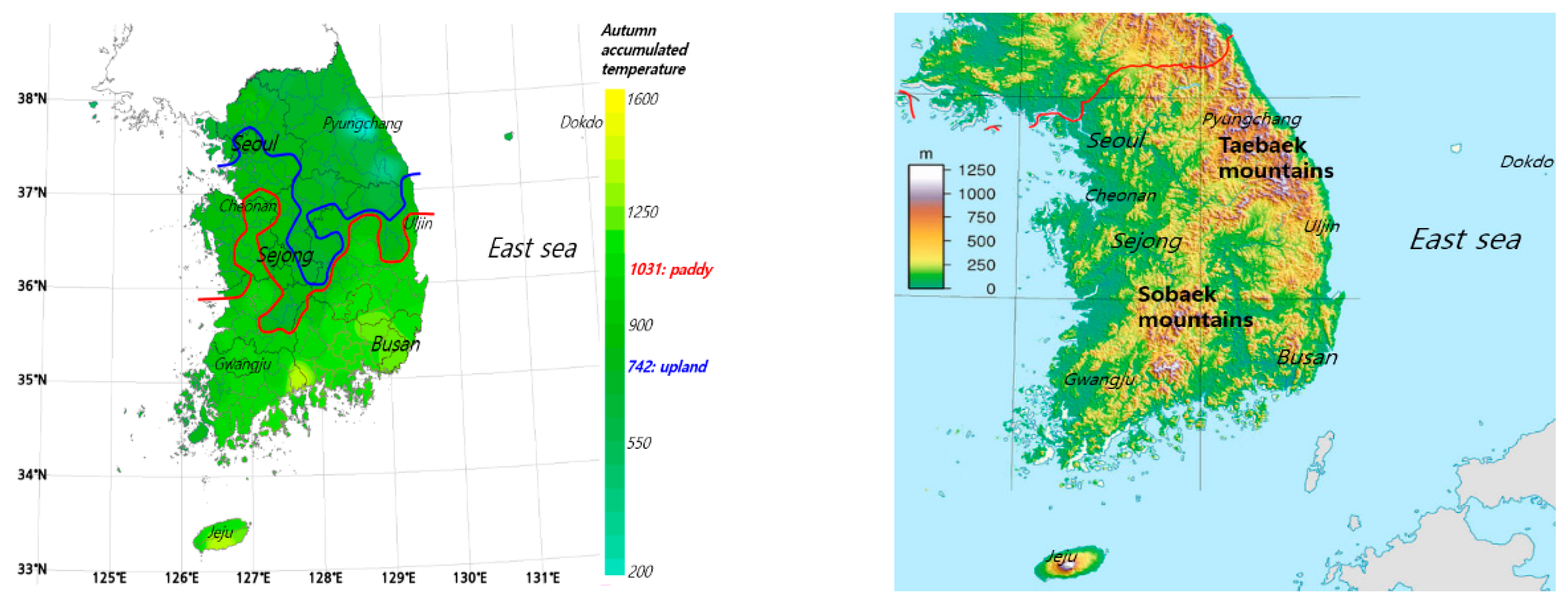Comparison of Causality of Temperature and Precipitation on Italian Ryegrass (Lolium Multiflorum Lam.) Yield between Cultivation Fields via Multi-Group Structural Equation Model Analysis in the Republic of Korea
Abstract
1. Introduction
2. Materials and Methods
2.1. Data and Variables
2.2. Data Processing and Analysis Method
3. Results and Discussion
3.1. Characteristics of Climatic and Yield Factors between Upland Fields and Paddy Fields
3.2. The Differences of Causality for Climatic Factors between Upland and Paddy Fields
3.3. Cultivation Suitability Classification between Upland and Paddy Fields
3.4. Proposals and Implications
4. Conclusions
Author Contributions
Funding
Acknowledgments
Conflicts of Interest
References
- Ghesquière, M.; Emile, J.C.; Jadas-Hécart, J.; Mousset, C.; Traineau, R.; Poisson, C. First in Vivo Assessment of Feeding Value of Festulolium Hybrids Derived from Festuca Arundinacea var, Glaucescens and Selection for Palatability. Plant Breed. 1996, 115, 238–244. [Google Scholar] [CrossRef]
- Ishii, Y.; Mukhtar, M.; Idota, S.; Fukuyama, K. Rotational Grazing System for Beef Cows on Dwarf Napiergrass Pasture Oversown with Italian Ryegrass for 2 Years after Establishment. Grassl. Sci. 2005, 51, 223–234. [Google Scholar] [CrossRef]
- Yang, Z.Y.; Xin, G.R.; Yuan, J.G.; Fang, W.; Li, G.X. Ecological fertilization: An example for paddy rice performed as a crop rotation system in southern China. In Fertilizers: Properties, Applications and Effects; Elsworth, L.R., Paley, W.O., Eds.; Nova Science Publishers Inc.: New York, NY, USA, 2008; pp. 1–28. [Google Scholar]
- Kim, M.J.; Choi, K.J.; Kim, J.G.; Seo, S.; Yoon, S.H.; Lim, Y.C.; Im, S.K.; Kwon, E.G.; Chang, S.S.; Kim, H.C.; et al. Effect of Varieties and Seeding Date on Overwinter and Dry Matter Yield of Italian Ryegrass in Paddy Field. J. Korean Soc. Grassl. Forage Sci. 2009, 29, 321–328. [Google Scholar]
- Shin, C.N.; Ko, K.H.; Kim, J.D. Agronomic characteristics and forage productivity of Italian ryegrass (Lolium Multiflorum Lam.) cultivar. J. Korean Soc. Grassl. Forage Sci. 2012, 32, 229–236. [Google Scholar] [CrossRef]
- Kim, K.G. The Core Statistics of Korean Agriculture, 2019; Farm & Agribusiness Management Division; Rural Development Administration: Cheonan, Korea, 2019; pp. 22–26. [Google Scholar]
- Cai, A.; Feng, W.; Zhang, W.; Xu, M. Climate, soil texture, and soil types affect the contributions of fine-fraction-stabilized carbon to total soil organic carbon in different land uses across China. J. Environ. Manag. 2016, 172, 2–9. [Google Scholar] [CrossRef]
- Ichihara, M.; Maruyama, K.; Yamashita, M.; Sawada, H.; Inagaki, H.; Ishida, Y.; Asai, M. Quantifying the ecosystem service of non-native weed seed predation provided by invertebrates and vertebrates in upland wheat fields converted from paddy fields. Agric. Ecosyst. Environ. 2011, 140, 191–198. [Google Scholar] [CrossRef]
- Williams, J.R. The erosion-productivity impact calculator (EPIC) model: A case history. Philos. Trans. R. Soc. Lond. Ser. B: Biol. Sci. 1990, 329, 421–428. [Google Scholar]
- Jones, J.W.; Hoogenboom, G.; Porter, C.H.; Boote, K.J.; Batchelor, W.D.; Hunt, L.A.; Wilkens, P.W.; Singh, U.; Gijsman, A.J.; Ritchie, J.T. The DSSAT cropping system model. Eur. J. Agron. 2003, 18, 235–265. [Google Scholar] [CrossRef]
- Basso, B.; Cammarano, D.; Carfagna, E. Review of crop yield forecasting methods and early warning systems. In Proceedings of the First Meeting of the Scientific Advisory Committee of the Global Strategy to Improve Agricultural and Rural Statistics, FAO Headquarters, Rome, Italy, 18 July 2013; pp. 18–19. [Google Scholar]
- Holzworth, D.P.; Huth, N.I.; deVoil, P.G.; Zurcher, E.J.; Herrmann, N.I.; McLean, G.; Chenu, K.; van Oosterom, E.J.; Snow, V.; Murphy, C.; et al. APSIM—Evolution towards a New Generation of Agricultural Systems Simulation. Environ. Model. Softw. 2014, 62, 327–350. [Google Scholar] [CrossRef]
- Feddes, R.A.; Kowalik, P.J.; Zaradny, H. Simulation of Field Water Use and Crop Yield; Centre for Agricultural Publishing and Documentation: Wageningen, The Netherlands, 1978. [Google Scholar]
- Martin, J.H.; Leonard, W.H. Principles of Field Crop Production, 2nd ed.; The Macmillan Company: New York, NY, USA, 1967. [Google Scholar]
- Peng, J.L.; Kim, M.; Kim, Y.J.; Jo, M.H.; Kim, B.W.; Sung, K.I.; Shen, J.L. Constructing Italian Ryegrass Yield Prediction Model Based on Climatic Data by Locations in South Korea. Grassl. Sci. 2017, 63, 184–195. [Google Scholar] [CrossRef]
- Arbuckle, J. Amos 18 User’s Guide; Armonk: Chicago, IL, USA, 2009. [Google Scholar]
- Kim, M.; Peng, J.; Sung, K. Causality of climate and soil factors affecting whole crop rye (Secale cereale L.) yield as part of natural ecosystem structure via longitudinal structural equation model in the Republic of Korea. Grassl. Sci. 2019. [Google Scholar] [CrossRef]
- Grace, J.B.; Carstenn, S.; Miao, S.; Sindhøj, E. Ecology in the Real World: How Might We Progress? In Real World Ecology; Springer: New York, NY, USA, 2009. [Google Scholar]
- Lam, T.Y.; Maguire, D.A. Structural Equation Modeling: Theory and Applications in Forest Management. Int. J. For. Res. 2012, 2012, 1–16. [Google Scholar] [CrossRef]
- Li, X.Y.; Wang, Y.R.; Wei, X.; Tai, J.H.; Jia, C.Z.; Hu, X.W.; Trethewey, J.A. Planting density and irrigation timing affects Cleistogenes songorica seed yield sustainability. Agron. J. 2014, 106, 1690–1696. [Google Scholar] [CrossRef]
- Zhang, T.; Lamb, E.G.; Soto-Cerda, B.; Duguid, S.; Cloutier, S.; Rowland, G.; Diederichsen, A.; Booker, H.M. Structural Equation Modeling of the Canadian Flax (Linum Usitatissimum L.) Core Collection for Multiple Phenotypic Traits. Can. J. Plant Sci. 2014, 94, 1325–1332. [Google Scholar] [CrossRef]
- Kim, M.; Sung, K.I.; Kim, Y.J. Analysis of Climate Effects on Italian Ryegrass Yield via Structural Equation Model. Korean J. Appl. Stat. 2014, 27, 111–120. [Google Scholar] [CrossRef]
- Kim, M.; Jeon, M.; Sung, K.I.; Kim, Y.J. Bayesian Structural Equation Modeling for Analysis of Climate Effect on Whole Crop Barley Yield. Korean. J. Appl. Stat. 2016, 29, 331–344. [Google Scholar] [CrossRef]
- Jöreskog, K.G.; Sörbom, D. LISREL 8: User’s Reference Guide; Scientific Software International: Lincolnwood, IL, USA, 1996. [Google Scholar]
- Song, X.Y.; Lee, S.Y. A tutorial on the Bayesian approach for analyzing structural equation models. J. Math. Psychol. 2012, 56, 135–148. [Google Scholar] [CrossRef]
- Dunson, D.B.; Palomo, J.; Bollen, K. Bayesian Structural Equation Modeling; SAMSI: Durham, NC, USA, 2005; pp. 1–36. [Google Scholar]
- Hooper, D.; Coughlan, J.; Mullen, M.R. Structural Equation Modelling: Guidelines for Determining Model Fit. Electron. J. Bus. Res. Methods 2008, 6, 53–60. [Google Scholar]
- Huang, C.C.; Chen, W.C.; Wang, C.C. Comparison of Taiwan Paddy-and Upland-Cultivated Taro (Colocasia esculenta L.) Cultivars for Nutritive Values. Food Chem. 2007, 102, 250–256. [Google Scholar] [CrossRef]
- Davies, P.J. The Plant Hormones: Their Nature, Occurrence, and Functions; Springer: Dordrecht, The Netherlands, 2010. [Google Scholar]
- Pessarakli, M. Handbook of Plant and Crop Physiology; CRC press: New York, NY, USA, 2014. [Google Scholar]
- Lydolph, P.E.; Temple, D.; Temple, D. The Climate of the Earth; Rowman & Littlefield Publishers Inc.: Lanham, MD, USA, 1985. [Google Scholar]
- Huang, J.; van den Dool, H.M. Monthly precipitation-temperature relations and temperature prediction over the United States. J. Clim. 1993, 6, 1111–1132. [Google Scholar] [CrossRef]
- Van Montfort, K.; Oud, J.; Satorra, A. Recent Developments on Structural Equation Models: THEORY and Applications; Springer Science & Business Media: Berlin, Germany, 2004. [Google Scholar]





| Variable (Unit) | Upland (n = 586) | Paddy (n = 142) | t-Value | ||
|---|---|---|---|---|---|
| Mean | SE | Mean | SE | ||
| Dry matter yield (kg/ha) | 10,916.41 | 178.20 | 8033.33 | 273.42 | 14.15 * |
| Fresh matter yield (kg/ha) | 58,315.71 | 826.65 | 38,927.22 | 1231.94 | 12.86 * |
| Autumn growing days (day) | 84.25 | 0.52 | 69.00 | 1.09 | 20.58 * |
| Autumn accumulated temperature (°C) | 878.91 | 8.62 | 632.07 | 16.23 | 25.72 * |
| Autumn precipitation amount (mm) | 114.21 | 3.18 | 78.54 | 4.46 | 6.62 * |
| Autumn precipitation days (day) | 18.54 | 0.21 | 16.97 | 0.38 | 4.15 * |
| Spring growing days (day) | 119.42 | 0.85 | 93.75 | 1.03 | 13.21 * |
| Spring accumulated temperature (°C) | 1199.8 | 13.24 | 725.41 | 13.02 | 10.39 * |
| Spring precipitation amount (mm) | 313.83 | 4.34 | 222.03 | 5.47 | 7.42 * |
| Spring precipitation days (day) | 43.22 | 0.46 | 34.96 | 0.66 | 13.17 * |
| Variable (Unit) | Upland (n = 586) | Paddy (n = 142) | ||||||
|---|---|---|---|---|---|---|---|---|
| 1 | 2 | 3 | 4 | 1 | 2 | 3 | 4 | |
| Autumn growing days (day) | −0.10 | 0.86 | 0.22 | 0.02 | −0.09 | 0.98 | 0.04 | −0.15 |
| Autumn accumulated temperature (°C) | 0.03 | 0.97 | 0.18 | −0.01 | −0.08 | 0.90 | 0.15 | −0.02 |
| Autumn precipitation amount (mm) | −0.08 | 0.12 | 0.89 | 0.05 | −0.06 | 0.11 | 0.95 | −0.05 |
| Autumn precipitation days (day) | −0.01 | 0.24 | 0.70 | 0.01 | −0.02 | 0.06 | 0.75 | 0.12 |
| Spring growing days (day) | 0.87 | 0.05 | −0.12 | 0.39 | 0.99 | −0.08 | −0.01 | −0.01 |
| Spring accumulated temperature (°C) | 0.94 | −0.12 | −0.02 | 0.30 | 0.93 | −0.07 | 0.02 | 0.13 |
| Spring precipitation amount (mm) | 0.26 | −0.07 | 0.02 | 0.79 | 0.34 | −0.05 | −0.10 | 0.21 |
| Spring precipitation days (day) | 0.24 | 0.07 | 0.05 | 0.62 | 0.19 | −0.13 | 0.12 | 0.97 |
| Loading (%) | 22.38 | 22.12 | 17.08 | 15.60 | 25.31 | 22.75 | 18.86 | 12.91 |
| Variable (Unit) | Upland (n = 586) | Paddy (n = 142) | t-Value | |
|---|---|---|---|---|
| Autumn temperature→Spring temperature | 0.13 * | 0.07 (p = 0.06) | −1.12 (p = 0.38) | |
| Autumn precipitation→Spring precipitation | 0.04 (p = 0.36) | 0.25 (p = 0.77) | - | |
| Autumn precipitation→Autumn temperature | 0.53 * | 0.11 * | 3.15 * | |
| Spring precipitation→Spring temperature | 0.93 * | 0.96 * | 0.12 (p = 0.45) | |
| Autumn temperature→Yield | 0.11 * | 0.48 * | 5.64 * | |
| Spring temperature→Yield | 0.50 * | 0.72 * | 2.43 * | |
| Autumn precipitation→Yield | −0.13 * | −0.70 (p = 0.18) | - | |
| Spring precipitation→Yield | 0.46 * | −0.01 (p = 0.93) | - | |
| Autumn temperature→AGD | 1 | 1 | - | |
| Autumn temperature→AAT | 0.85 * | 0.89 * | −0.93 (p = 0.18) | |
| Autumn precipitation→APD | 1 | 1 | - | |
| Autumn precipitation→APA | 1.16 * | 1.39* | −0.53 (p = 0.30) | |
| Spring temperature→SGD | 1 | 1 | - | |
| Spring temperature→SAT | 0.94 * | 0.76* | 6.38 * | |
| Spring precipitation→SPD | 1 | 1 | - | |
| Spring precipitation→SPA | 1.14 * | 0.34 (p = 0.43) | - | |
| Yield→DMY | 1 | 1 | - | |
| Yield→FMY | 0.97 * | 0.99 * | 1.13 (p = 0.13) | |
| Fitness | SRMR (<0.08) | 0.06 | 0.05 | |
| GFI (>0.90) | 0.90 | 0.86 | ||
| CFI (>0.90) | 0.92 | 0.90 | ||
| Parsimony | PGFI | 0.43 | 0.37 | |
| PCFI | 0.53 | 0.48 | ||
| Factors | Autumn Temperature | Autumn Precipitation | Spring Temperature | Spring Precipitation | ||
|---|---|---|---|---|---|---|
| Yield | Upland | Direct | 0.11 | −0.13 | 0.50 | 0.46 |
| Indirect | 0.06 | 0.06 | - | 0.47 | ||
| Total (A) | 0.17 | −0.07 | 0.50 | 0.93 | ||
| Paddy | Direct | 0.48 | - | 0.72 | - | |
| Indirect | - | 0.05 | - | 0.69 | ||
| Total (B) | 0.48 | 0.05 | 0.72 | 0.69 | ||
| Ratio of total effect (|B/A|) | 2.82 | 0.71 | 1.44 | 0.74 | ||
© 2019 by the authors. Licensee MDPI, Basel, Switzerland. This article is an open access article distributed under the terms and conditions of the Creative Commons Attribution (CC BY) license (http://creativecommons.org/licenses/by/4.0/).
Share and Cite
Kim, M.; Sung, K. Comparison of Causality of Temperature and Precipitation on Italian Ryegrass (Lolium Multiflorum Lam.) Yield between Cultivation Fields via Multi-Group Structural Equation Model Analysis in the Republic of Korea. Agriculture 2019, 9, 254. https://doi.org/10.3390/agriculture9120254
Kim M, Sung K. Comparison of Causality of Temperature and Precipitation on Italian Ryegrass (Lolium Multiflorum Lam.) Yield between Cultivation Fields via Multi-Group Structural Equation Model Analysis in the Republic of Korea. Agriculture. 2019; 9(12):254. https://doi.org/10.3390/agriculture9120254
Chicago/Turabian StyleKim, Moonju, and Kyungil Sung. 2019. "Comparison of Causality of Temperature and Precipitation on Italian Ryegrass (Lolium Multiflorum Lam.) Yield between Cultivation Fields via Multi-Group Structural Equation Model Analysis in the Republic of Korea" Agriculture 9, no. 12: 254. https://doi.org/10.3390/agriculture9120254
APA StyleKim, M., & Sung, K. (2019). Comparison of Causality of Temperature and Precipitation on Italian Ryegrass (Lolium Multiflorum Lam.) Yield between Cultivation Fields via Multi-Group Structural Equation Model Analysis in the Republic of Korea. Agriculture, 9(12), 254. https://doi.org/10.3390/agriculture9120254





